tow bar Peugeot Partner Tepee 2016 Owner's Manual
[x] Cancel search | Manufacturer: PEUGEOT, Model Year: 2016, Model line: Partner Tepee, Model: Peugeot Partner Tepee 2016Pages: 296, PDF Size: 10.76 MB
Page 5 of 296
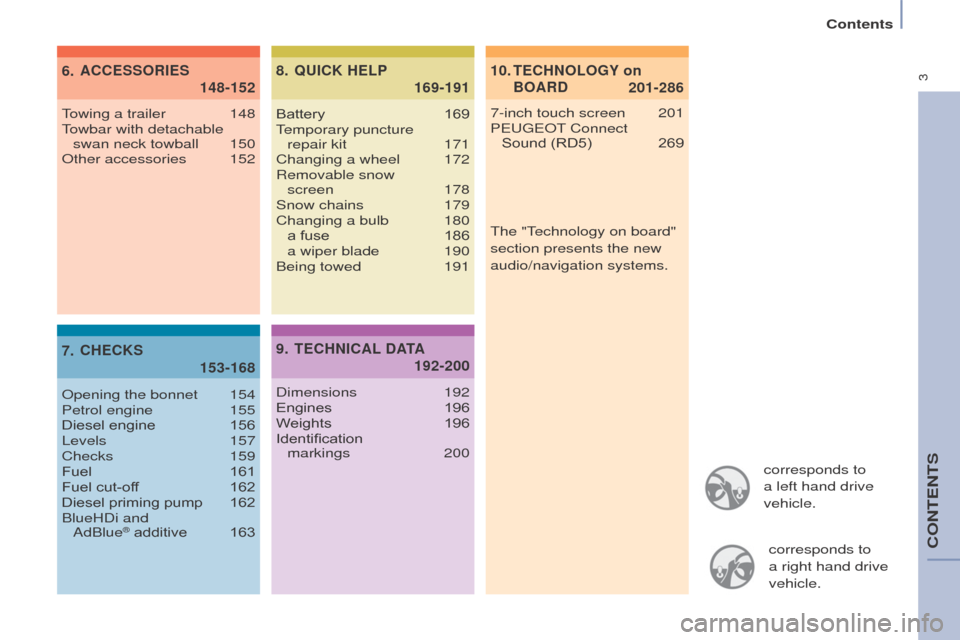
3
Contents
corresponds to
a left hand drive
vehicle.corresponds to
a
right hand drive
vehicle.
10.
201-286
te CHN o L og Y on
B o ARD
6.
148-152
ACC
e
SS
o
RI
e
S
7.
153-168
CH
e
CKS 8.
169-191
Q
u
ICK H
e
LP
7-inch touch screen 201
P eugeo T Connect
Sound (RD5)
269
T
owing a trailer
148
T
owbar with detachable swan neck towball
150o
ther accessories
152
o
pening the bonnet
154
Petrol engine
155
Diesel engine
156
Levels
157
Checks
159
Fuel
161
Fuel cut-of
f
162
Diesel priming pump
162
BlueHDi and
AdBlue
® additive 163 Battery
169
T
emporary puncture
repair kit
171
Changing a wheel
172
Removable snow
screen 178
Snow chains
179
Changing a bulb
180 a fuse
186 a wiper blade
190
Being towed
191
9.
192-200
te
CHNICAL DAtA
Dimensions 192
Engines 196
W
eights
196
Identification
markings
200The "Technology on board"
section presents the new
audio/navigation systems.
CoNTeNTS
Page 7 of 296
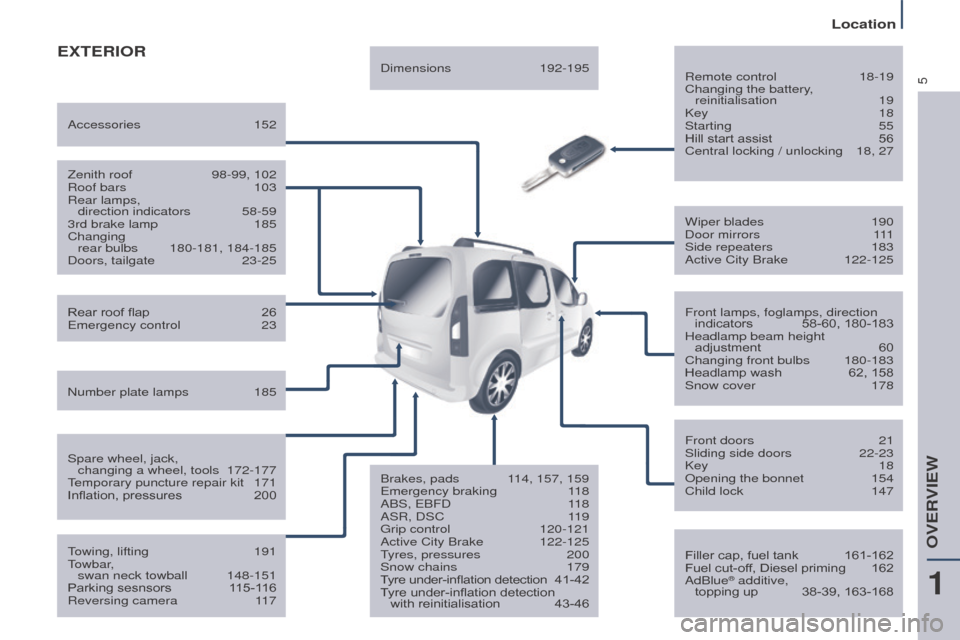
5
Location
exteRIoR
Remote control 18-19
Changing the battery ,
reinitialisation
19
Key
18
Starting
55
Hill start assist
56
Central locking / unlocking
18, 27
Filler cap, fuel tank
161-162
Fuel cut-of
f, Diesel priming
162
AdBlue® additive,
topping up 38-39, 163-168
Wiper blades
190
Door mirrors
1
11
Side repeaters
183
Active City Brake
122-125
Front lamps, foglamps, direction indicators
58-60, 180-183
Headlamp beam height adjustment
60
Changing front bulbs
180-183
Headlamp wash
62, 158
Snow cover
178
Front doors
21
Sliding side doors
22-23
Key
18o
pening the bonnet
154
Child lock
147
T
owing, lifting
191
T
owbar,
swan neck towball
148-151
Parking sesnsors
1
15-116
Reversing camera
1
17
Rear roof flap
26e
mergency control
23
Spare wheel, jack,
changing a wheel, tools
172-177
T
emporary puncture repair kit
171
Inflation, pressures
200
Zenith roof
98-99, 102
Roof bars
103
Rear lamps,
direction indicators
58-59
3rd brake lamp
185
Changing
rear bulbs
180-181, 184-185
Doors, tailgate
23-25
Accessories
152
Dimensions
192-195
Brakes, pads
1
14, 157, 159
e
mergency braking
1
18
ABS,
e
BFD
1
18
ASR, DSC
1
19
g
rip control
120-121
Active City Brake
122-125
T
yres, pressures
200
Snow chains
179
T
yre under-inflation detection
4
1-42
Tyre under-inflation detection with reinitialisation
43-46
Number plate lamps
185
1
oVeRVIeW
Page 93 of 296

91
Seats
operating the Row 3 seats
Removing the seat
-
Lower the head restraint.
-
Place the seat in the fully folded
position.
-
T
ilt the entire seat forwards.
-
o n each side, take hold of the
uprights of the folded seat, tilting it
forward slightly, and lift it. Refitting the seat
The label on the seat indicates the
position in which it must be installed.
-
Place the hooks of the front feet
between the two bars.
-
e nsure that no object or foot is
obstructing the rear anchorage
points and that the seat belt is
positioned correctly and available
for use.
-
Fold back the seat to fix its rear
anchoring feet.
-
o perate the control to raise the
seat back to its initial position.
-
Raise the head restraint.
good practice
Following the various operations:
-
do not remove a head restraint
without stowing it; secure it inside
the vehicle,
-
ensure that the passengers can
always access the seat belts and
fasten them easily
,
-
passengers must never take
their seat without adjusting and
fastening their seat belt.
-
a passenger seated in row 3 must
ensure that he does not obstruct
the row 2 seat anchorage points,
-
a passenger seated in row 3 must
not have the seat in front of them in
row 2 in the folded position; this is
in case the seat could tip towards
the passenger unexpectedly and
injure them.
Do not place hard or heavy objects on
the seat backs forming a table, they
could become dangerous projectiles in
the event or sharp braking or impact.
eASe oF uSe and CoMFoRT
4
Page 104 of 296
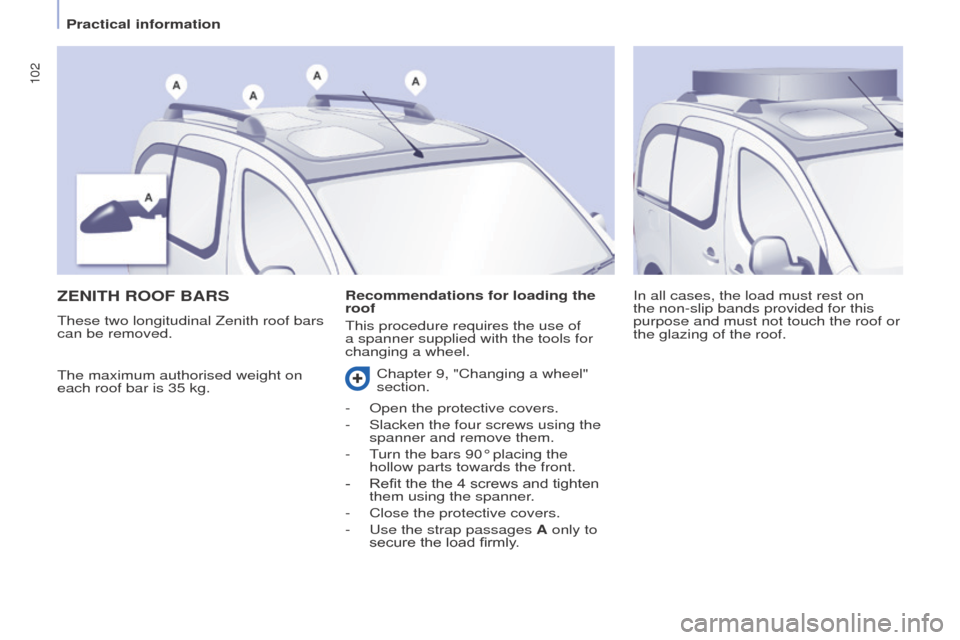
102
ZeNItH RooF BARS
The maximum authorised weight on
each roof bar is 35 kg.In all cases, the load must rest on
the non-slip bands provided for this
purpose and must not touch the roof or
the glazing of the roof.
Recommendations for loading the
roof
This procedure requires the use of
a spanner supplied with the tools for
changing a wheel.
These two longitudinal Zenith roof bars
can be removed.
Chapter 9, "Changing a wheel"
section.
-
o pen the protective covers.
-
Slacken the four screws using the
spanner and remove them.
-
T
urn the bars 90° placing the
hollow parts towards the front.
-
Refit the the 4 screws and tighten
them using the spanner
.
-
Close the protective covers.
-
u se the strap passages A only to
secure the load firmly.
Practical information
Page 108 of 296
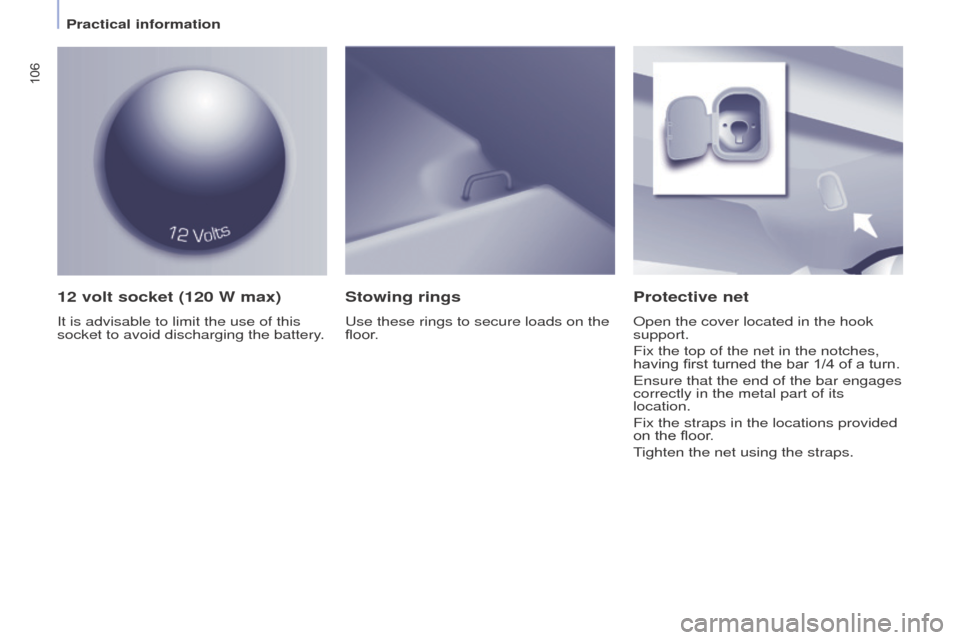
106
12 volt socket (120 W max)
It is advisable to limit the use of this
socket to avoid discharging the battery.
Protective net
open the cover located in the hook
support.
Fix the top of the net in the notches,
having first turned the bar 1/4 of a turn.
e
nsure that the end of the bar engages
correctly in the metal part of its
location.
Fix the straps in the locations provided
on the floor.
Tighten the net using the straps.
Stowing rings
use these rings to secure loads on the
floor .
Practical information
Page 118 of 296
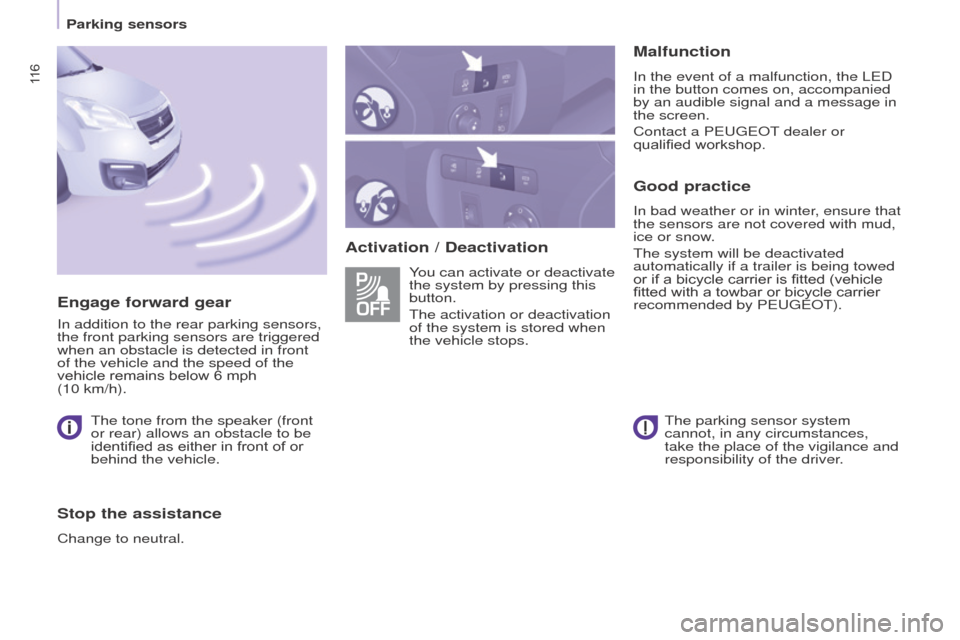
11 6
Activation / DeactivationMalfunction
In the event of a malfunction, the LeD
in the button comes on, accompanied
by an audible signal and a message in
the screen.
Contact a P
eugeo T dealer or
qualified workshop.
good practice
In bad weather or in winter, ensure that
the sensors are not covered with mud,
ice or snow.
The system will be deactivated
automatically if a trailer is being towed
or if a bicycle carrier is fitted (vehicle
fitted with a towbar or bicycle carrier
recommended by P
eugeo T).
You can activate or deactivate
the system by pressing this
button.
The activation or deactivation
of the system is stored when
the vehicle stops.
engage forward gear
In addition to the rear parking sensors,
the front parking sensors are triggered
when an obstacle is detected in front
of the vehicle and the speed of the
vehicle remains below 6 mph
(10 km/h).
The tone from the speaker (front
or rear) allows an obstacle to be
identified as either in front of or
behind the vehicle.
Stop the assistance
Change to neutral. The parking sensor system
cannot, in any circumstances,
take the place of the vigilance and
responsibility of the driver.
Parking sensors
Page 151 of 296
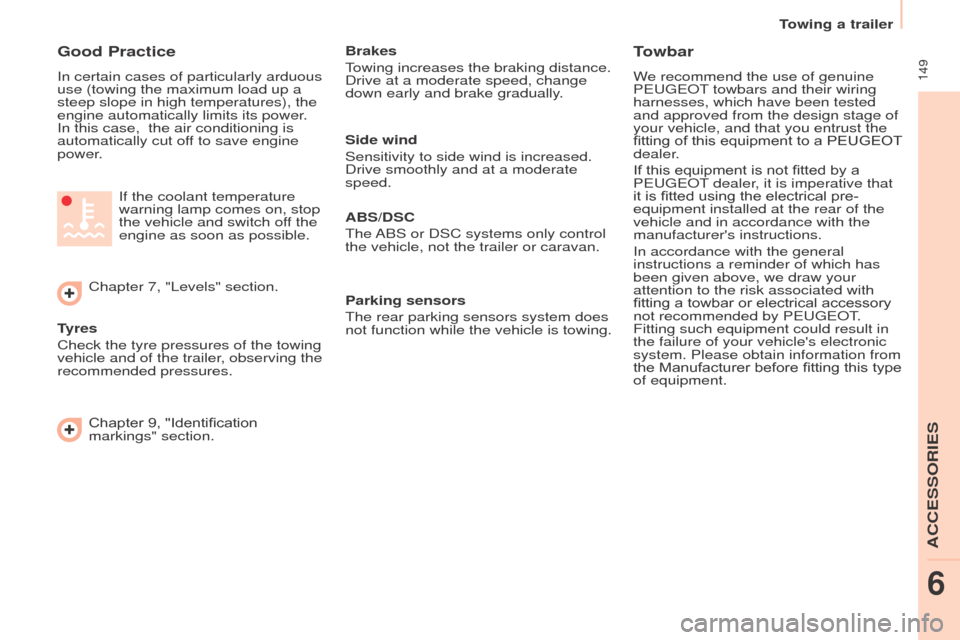
149
towing a trailer
good Practice
In certain cases of particularly arduous
use (towing the maximum load up a
steep slope in high temperatures), the
engine automatically limits its power.
In this case, the air conditioning is
automatically cut off to save engine
power.
tyres
Check the tyre pressures of the towing
vehicle and of the trailer
, observing the
recommended pressures. Chapter 7, "Levels" section.If the coolant temperature
warning lamp comes on, stop
the vehicle and switch off the
engine as soon as possible. Brakes
Towing increases the braking distance.
Drive at a moderate speed, change
down early and brake gradually.
towbar
We recommend the use of genuine
P
eugeo T towbars and their wiring
harnesses, which have been tested
and approved from the design stage of
your vehicle, and that you entrust the
fitting of this equipment to a PEUGEOT
dealer.
If this equipment is not fitted by a
P
eugeo T dealer, it is imperative that
it is fitted using the electrical pre-
equipment installed at the rear of the
vehicle and in accordance with the
manufacturer's instructions.
In accordance with the general
instructions a reminder of which has
been given above, we draw your
attention to the risk associated with
fitting a towbar or electrical accessory
not recommended by P
eugeo T.
Fitting such equipment could result in
the failure of your vehicle's electronic
system. Please obtain information from
the Manufacturer before fitting this type
of equipment.
Side wind
Sensitivity to side wind is increased.
Drive smoothly and at a moderate
speed.
ABS/DSC
The ABS or DSC systems only control
the vehicle, not the trailer or caravan.
Parking sensors
The rear parking sensors system does
not function while the vehicle is towing.
Chapter 9, "Identification
markings" section.
ACCeSSoRIeS
6
Page 152 of 296
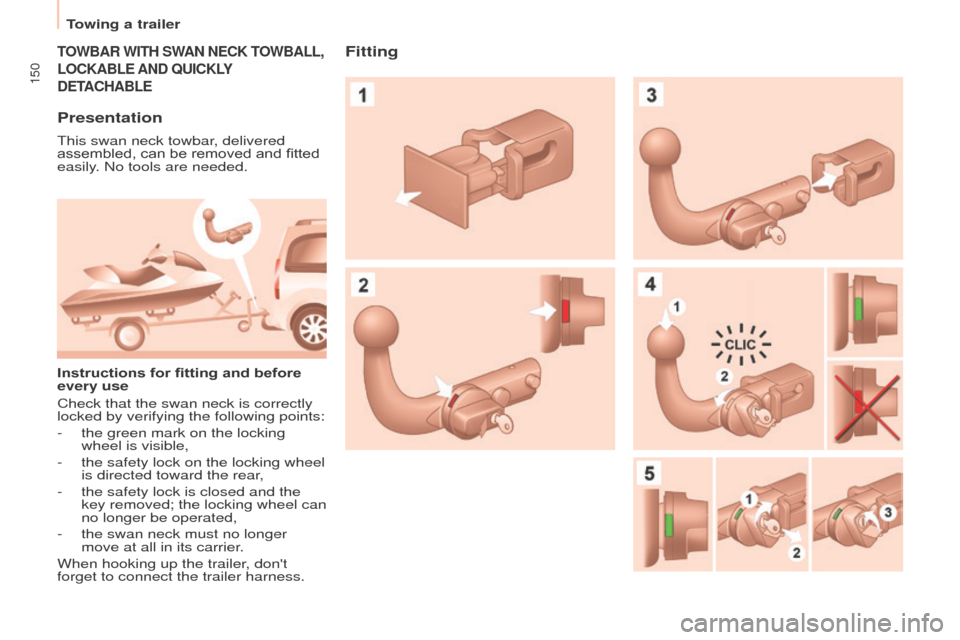
150
towing a trailer
toWBAR WI t H SWAN N e CK to WBALL ,
L
o CKABL e AND
Q
u ICKLY
D
et
ACHABL
e
Presentation
This swan neck towbar, delivered
assembled, can be removed and fitted
easily. No tools are needed.
Instructions for fitting and before
every use
Check that the swan neck is correctly
locked by verifying the following points:
-
the green mark on the locking
wheel is visible,
-
the safety lock on the locking wheel
is directed toward the rear
,
-
the safety lock is closed and the
key removed; the locking wheel can
no longer be operated,
-
the swan neck must no longer
move at all in its carrier
.
When hooking up the trailer, don't
forget to connect the trailer harness.
Fitting
Page 174 of 296
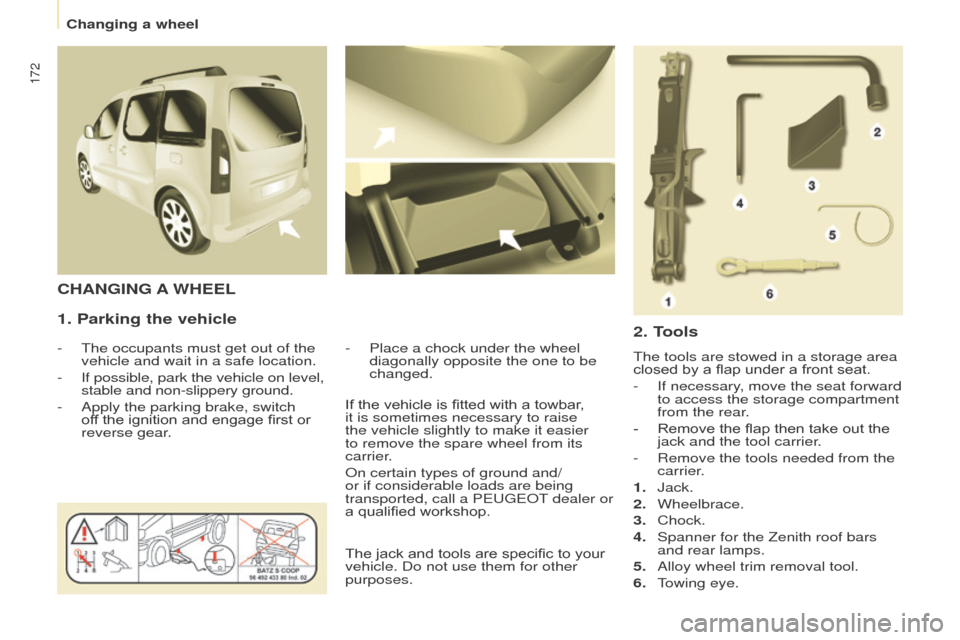
172
1. Parking the vehicle
- The occupants must get out of the
vehicle and wait in a safe location.
-
If possible, park the vehicle on level,
stable and non-slippery ground.
-
Apply the parking brake, switch
of
f the ignition and engage first or
reverse gear. -
Place a chock under the wheel
diagonally opposite the one to be
changed.
CHANgINg A WH
ee L
2.
t
ools
The tools are stowed in a storage area
closed by a flap under a front seat.
-
If necessary
, move the seat forward
to access the storage compartment
from the rear.
-
Remove the flap then take out the
jack and the tool carrier
.
-
Remove the tools needed from the
carrier
.
1.
Jack.
2.
Wheelbrace.
3.
Chock.
4.
Spanner for the Zenith roof bars
and rear lamps.
5.
Alloy wheel trim removal tool.
6.
T
owing eye.
If the vehicle is fitted with a towbar,
it is sometimes necessary to raise
the vehicle slightly to make it easier
to remove the spare wheel from its
carrier.
o
n certain types of ground and/
or if considerable loads are being
transported, call a P
eugeo
T dealer or
a qualified workshop.
The jack and tools are specific to your
vehicle. Do not use them for other
purposes.
Changing a wheel